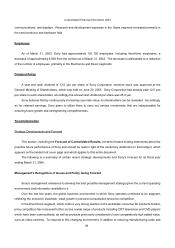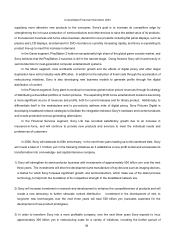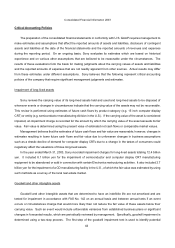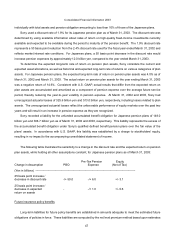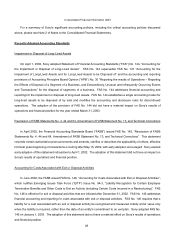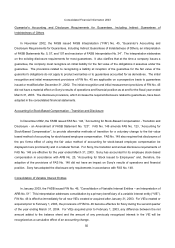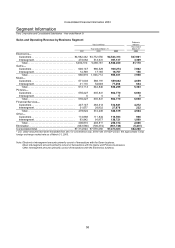Sony 2003 Annual Report Download - page 134
Download and view the complete annual report
Please find page 134 of the 2003 Sony annual report below. You can navigate through the pages in the report by either clicking on the pages listed below, or by using the keyword search tool below to find specific information within the annual report.
Consolidated Financial Information 2003
48
as to future investment yield, mortality, morbidity, withdrawals and other factors. Future policy benefits are computed
using interest rates ranging from approximately 1.00% to 5.50%. Mortality, morbidity and withdrawal assumptions for
all policies are based on either the life insurance subsidiary’s own experience or various actuarial tables. Generally
these assumptions are “locked-in” upon the issuance of new insurance. While management believes that the
assumptions used are appropriate, differences in actual experience or changes in assumptions may affect Sony’s
future insurance policy benefits.
Tax asset valuation
In establishing the appropriate valuation reserve for tax loss carry-forwards, all available evidence, both positive
and negative, is considered. Information on historical results is supplemented by all currently available information
on future years, as realization of tax loss carry-forwards is dependent on each company or tax filing unit generating
sufficient taxable income prior to expiration of the loss carryforwards. The estimates and assumptions used in
determining future taxable income are consistent with those used in Sony’s approved forecasts of future operations.
Although realization is not assured, management believes it is more likely than not that all of the deferred tax assets,
less valuation allowance, will be realized. The amount of such net deferred tax assets which are considered
realizable, however, could change in the near term if estimates of future taxable income during the carryforward
period are changed. A decrease in the amount of deferred tax assets considered realizable due to a change in the
estimate of future taxable income may result in higher income tax expense in future periods.
Film accounting
An aspect of film accounting that requires the exercise of judgment relates to the process of estimating the total
revenues to be received throughout a film's life cycle. Such estimate of a film's ultimate revenue is important for two
reasons. First, while a film is being produced and the related costs are being capitalized, it is necessary for
management to estimate the ultimate revenue, less additional costs to be incurred, including exploitation costs which
are expensed as incurred, in order to determine whether the value of a film has been impaired and thus requires an
immediate write off of unrecoverable film costs. Second, the amount of film costs recognized as cost of sales for a
given film as it is exhibited in various markets throughout its life cycle is based upon the proportion that current period
actual revenues bear to the estimated ultimate total revenues.
Management bases its estimates of ultimate revenue for each film on several factors including the historical
performance of similar genre films, the star power of the lead actors and actresses, the expected number of theaters
at which the film will be released, anticipated performance in the home entertainment, television and other ancillary
markets, and agreements for future sales. Management updates such estimates based on the actual results to date
of each film. For example, a film that has resulted in lower than expected theatrical revenues in its initial weeks of
release would generally have its theatrical, home video and distribution ultimate revenues adjusted downward; a
failure to do so would result in the understatement of amortized film costs for the period. Since the total film cost to be
amortized for a given film is fixed, the estimate of ultimate revenues impacts only the timing of film cost amortization.


